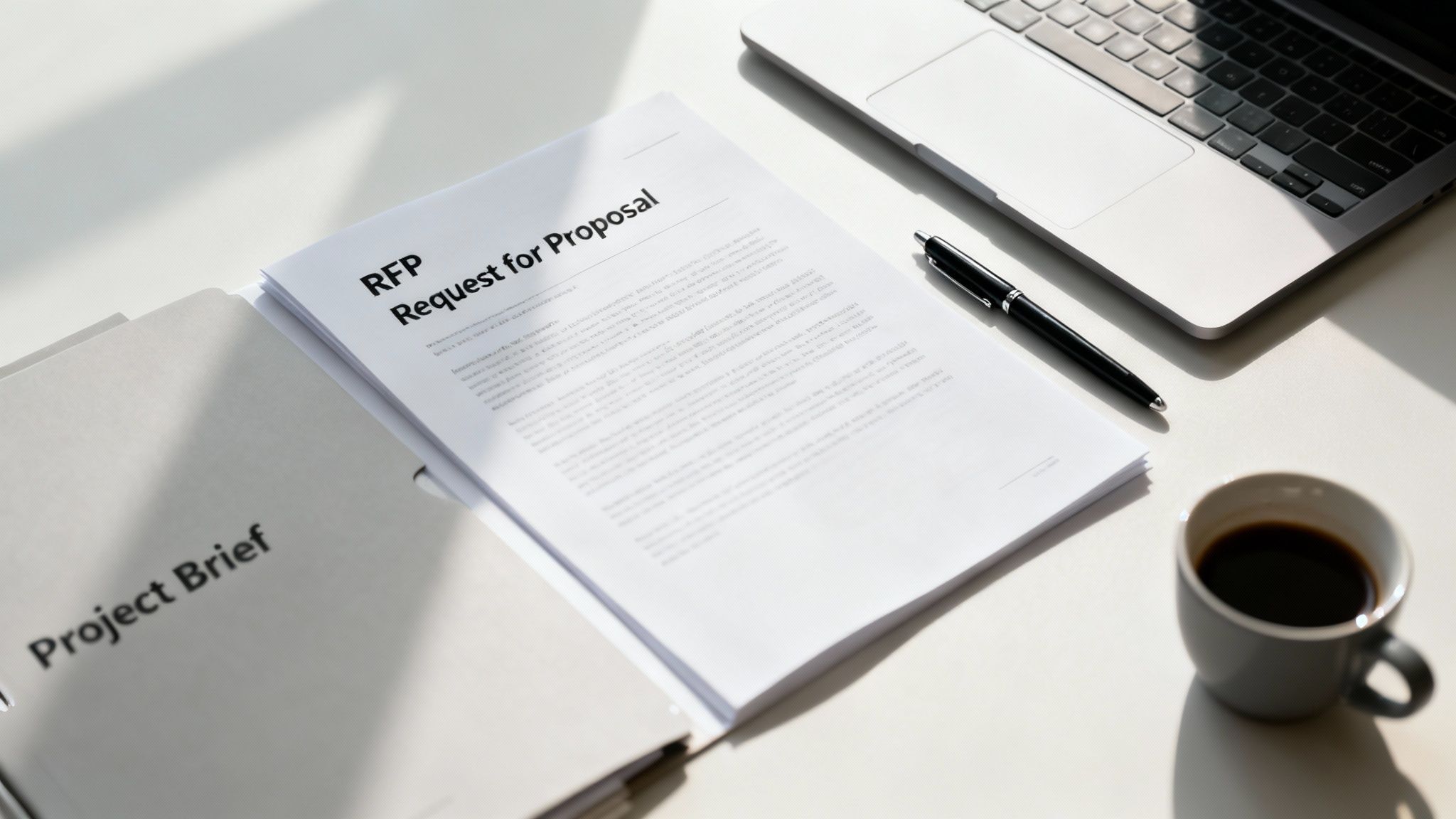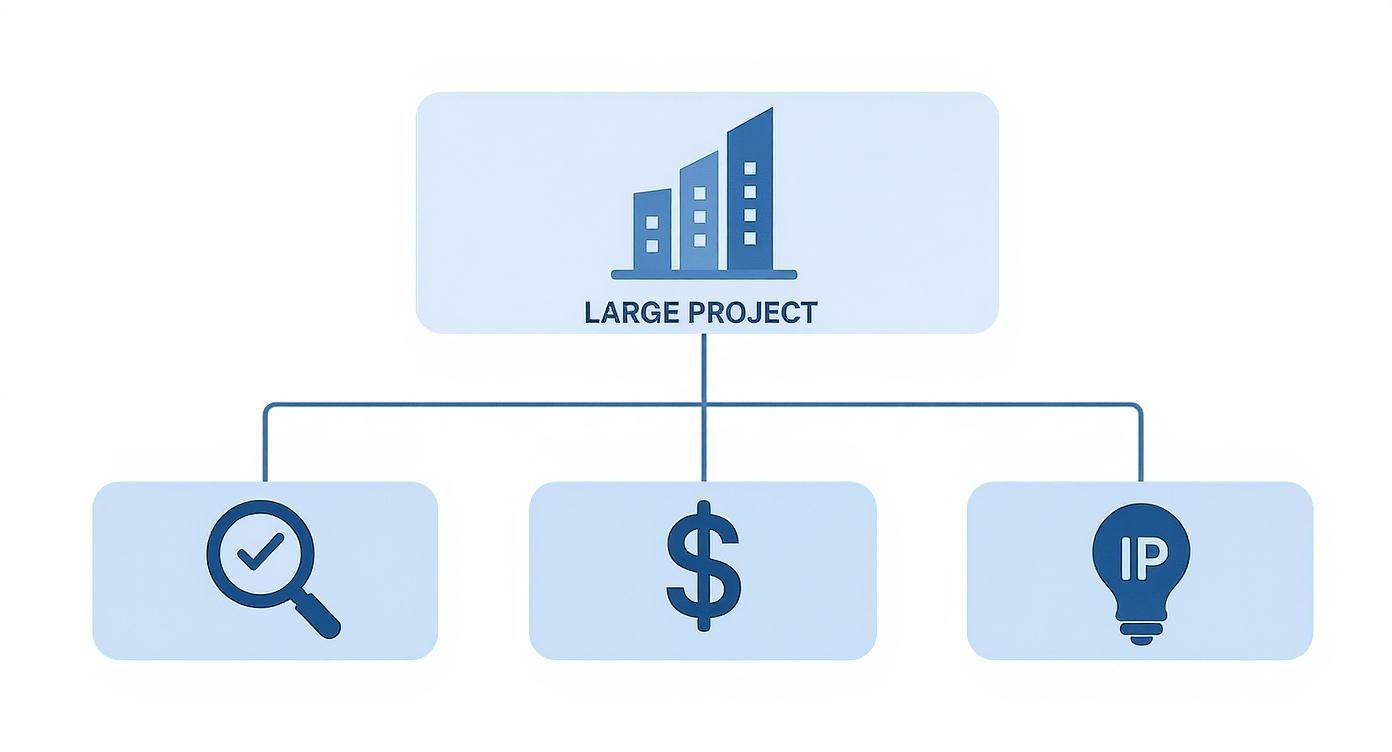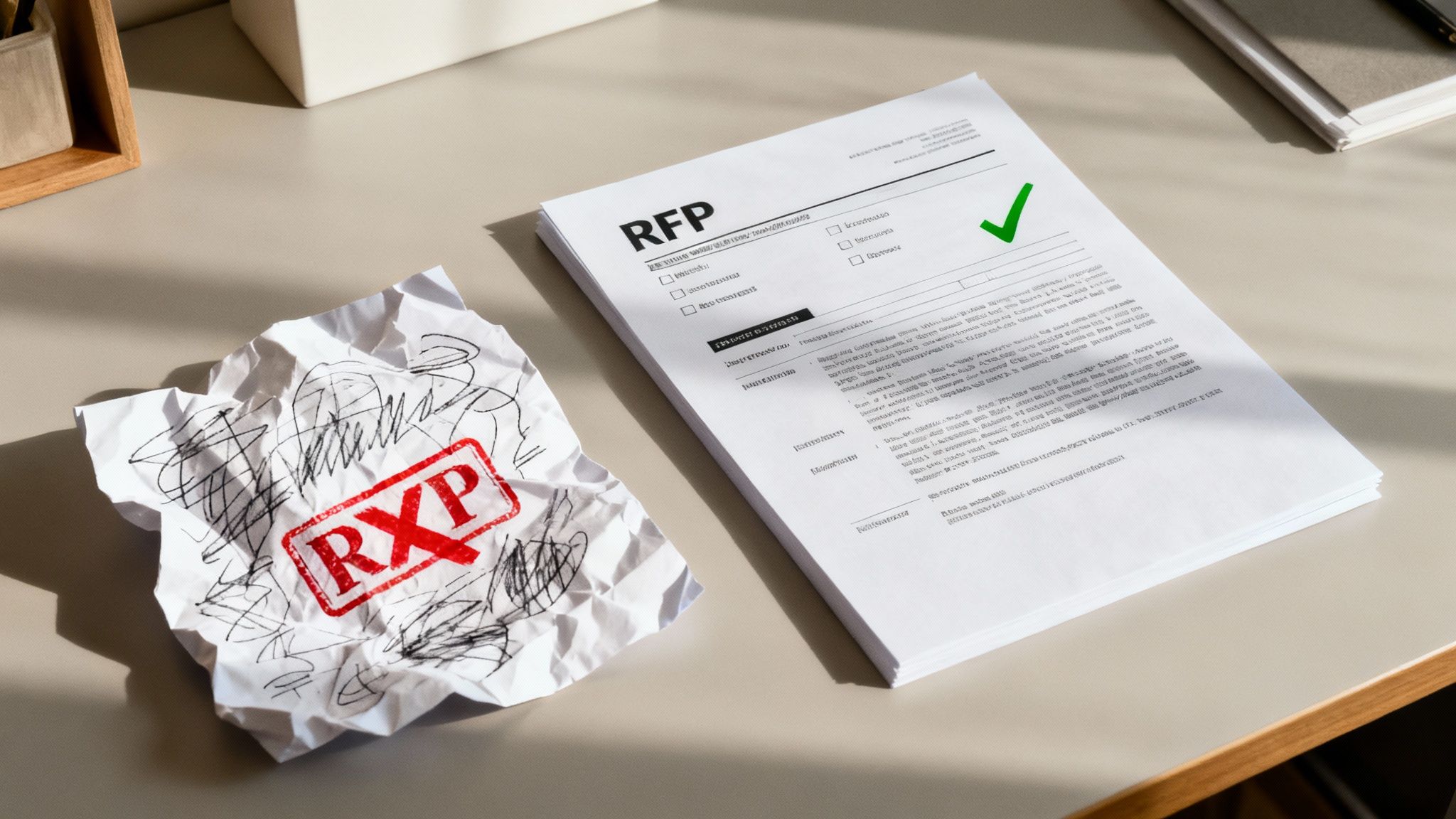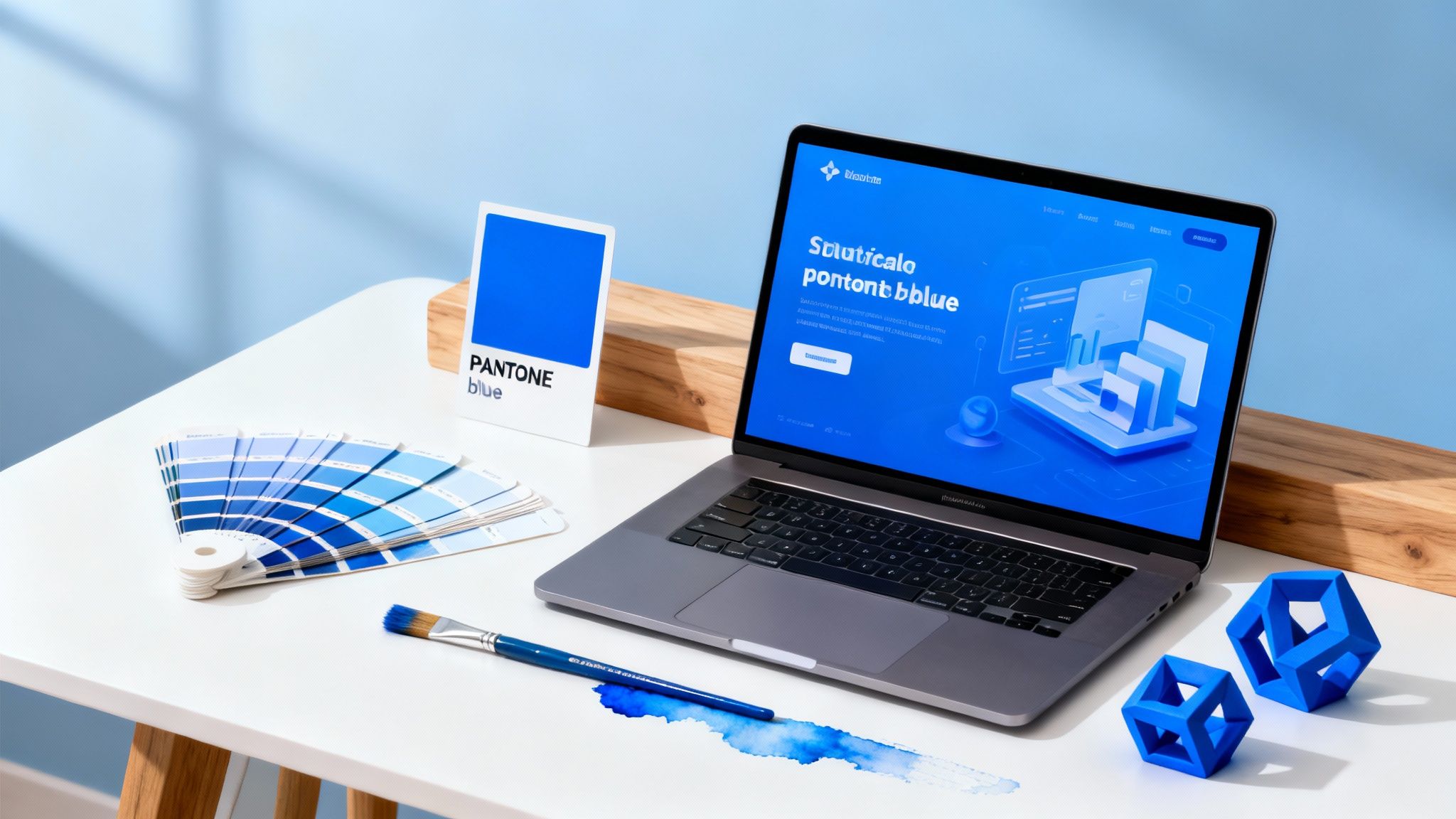Finding the right creative partner for a high-stakes visual project can be a complex challenge. A well-crafted Request for Proposal (RFP) is the strategic tool that brings clarity and safety to the process. It’s a formal document your organisation uses to solicit competitive bids from potential vendors, ensuring a fair, compliant, and transparent selection. For creative teams looking to produce innovative visual content, mastering the RFP is essential.
Before you start generating brilliant visual concepts with a new partner, you need a solid foundation. If you're ready to see how a compliant and secure platform can transform your creative workflow, try VirtuallPRO's Creative AI OS. You can start for free and discover a faster way to move from idea to final asset.
Demystifying the Request for Proposal

Think of an RFP less like a rigid questionnaire and more like a strategic project blueprint. Its real job is to clearly explain your creative needs and invite vendors to demonstrate how they’d solve your visual communication challenges. This simple shift in mindset turns a daunting task into a massive advantage, especially for complex visual and AI-driven creative projects.
Before you start writing, it’s critical to understand why you're even creating an RFP in the first place. A great RFP does more than just get you quotes; it lays the groundwork for a secure and successful partnership by making sure everyone is on the same page from day one.
Why Is an RFP So Important?
A strong RFP is essential because it formalises the entire procurement process, which keeps things fair and transparent for everyone. For any enterprise that prioritises responsible, compliant, and safe operations—like we do here at Virtuall—this kind of structured approach is non-negotiable.
It also forces you to define your project with absolute precision. That clarity helps potential creative partners deliver relevant, high-quality proposals that actually meet your visual content needs.
By issuing a detailed RFP, you can:
- Ensure Comparability: You get proposals that all answer the same questions, making it way easier to compare vendors apples-to-apples.
- Attract Innovation: You give creative agencies and tech partners a chance to impress you with their best ideas and forward-thinking visual solutions.
- Mitigate Risk: You clearly define expectations around deliverables, timelines, intellectual property, and budget, which prevents major headaches later on.
- Save Time: A structured process cuts down on the endless back-and-forth that plagues less formal hiring methods.
The Strategic Value Beyond Procurement
Forget just finding a vendor for a minute. The process of writing an RFP brings huge value to your own team. It forces all of your key stakeholders to sit down and agree on the project’s goals, scope, and what success actually looks like before you ever talk to an external partner. Getting that internal alignment is a game-changer for any visual project.
A well-structured request for proposal is the cornerstone of effective project management, turning ambiguity into a clear roadmap for success. It ensures that everyone, from your internal team to your future partner, is working towards the same vision.
This clarity is especially crucial in the fast-paced world of creative production. Building this strong foundation helps you manage the entire project lifecycle much more smoothly. For more on that, check out our guide on effective creative team project management.
Ultimately, the RFP isn’t just paperwork. It’s your first and best tool for building a successful, secure, and compliant creative partnership.
When to Use an RFP for Creative Projects
Knowing when to send out a request for proposal is just as important as knowing how to write one. Using an RFP for a tiny, straightforward visual task is like using a sledgehammer to crack a nut—it’s just overkill. But for a complex, high-stakes creative project? It’s the architectural plan you can’t build without.
Think of the RFP process as a strategic tool, not just another piece of administrative paperwork. The real decision to use one boils down to two things: project complexity and value. It’s the right move when the stakes are high and the details really, really matter. A formal process ensures you’re comparing potential partners on a level playing field, which is critical for any enterprise serious about safe and compliant work.
High-Stakes and Complex Initiatives
A request for proposal is essential for big creative projects where any grey area could lead to serious financial or reputational damage. We're talking about projects where the scope, budget, intellectual property, and technical specs for visual assets are completely non-negotiable.
You should seriously consider an RFP for projects like:
- Complete Brand Redesigns: When you're overhauling your entire visual identity, you need a partner who gets your brand's DNA and can execute perfectly across every single touchpoint.
- Major Advertising Campaigns: For any initiative with a significant media spend, an RFP helps you properly vet agencies on their creative ideas, media buying strategies, and how they'll measure performance.
- Integrating Advanced AI Tools: When bringing on a new creative OS like VirtuallPRO, an RFP lets you precisely assess a vendor’s technical know-how, data security protocols, and integration capabilities.
- Large-Scale Content Production: If you need a massive volume of visual assets for a product launch or a global campaign, an RFP brings much-needed clarity to deliverables, quality standards, and timelines.
An RFP formalises the whole selection game, sparking fair competition and keeping things transparent. This structured approach cuts down on risk and makes sure every potential partner is measured by the same yardstick, protecting your organisation's interests.
This kind of structured thinking isn’t just for corporate procurement. In Denmark, for example, RFPs are central to how public research funding is handled. The Danida Call for Proposals 2025 uses a two-phase RFP system to hand out grants of up to 10 million DKK for development projects, guaranteeing a transparent and deep evaluation of every applicant. You can see how structured proposals are used in Denmark to get a sense of this highly organised approach.
Fostering Competition and Transparency
Beyond just managing complexity, a huge reason to issue an RFP is to stir up some healthy competition. By inviting multiple qualified vendors to the table, you get a much wider pool of ideas, strategies, and price points. This competitive pressure often pushes vendors to bring their most innovative and cost-effective solutions forward.
All this transparency is also key for staying compliant. A well-documented RFP process leaves a clear audit trail, showing exactly how and why a particular vendor was chosen. This protects your organisation from any claims of favouritism and proves that your decisions are based purely on merit and value.
When it comes down to it, the RFP is your best bet for making smart, defensible decisions on your most important creative ventures.
Anatomy of a Perfect Creative RFP
A great request for proposal is so much more than a laundry list of questions; it's the blueprint for your entire visual project. Each section has a specific job, guiding potential partners from the big picture right down to the nitty-gritty details. Getting this structure right is the secret to getting back proposals that are clear, easy to compare, and genuinely innovative.
Think of it like building a house. You wouldn't just tell an architect you want "a nice house." You'd give them a detailed plan—the number of rooms, the style, the materials, the budget. Your RFP does the exact same job for a creative project.
When you're dealing with big, complex projects, a few core pillars hold everything up: the scope, the budget, and the intellectual property. Nail these, and you've got a solid foundation.

Defining these elements with absolute clarity from the start is what separates a smooth project from a chaotic one. It gives everyone a stable framework to build on.
Writing a Compelling Project Overview
This is your first impression. Your project overview needs to grab a potential partner's attention and quickly set the stage without drowning them in jargon. This is your chance to tell a story about what you want to achieve and, crucially, why it matters to your business.
A solid overview should immediately answer three things:
- What is the project? Give a brief, clear description (e.g., "A global digital ad campaign for our new product launch, focused on compelling visual storytelling").
- What problem are you solving? Explain the business challenge (e.g., "We need to boost brand awareness with a younger demographic through visually engaging content").
- What does success look like? Define your ultimate goal in concrete terms (e.g., "Achieve a 25% lift in engagement on our visual social platforms like Instagram and TikTok").
A well-written brief is the heart of any creative project. If you want to dive deeper, there's a fantastic guide on how to write a creative brief that's full of practical tips.
Defining a Detailed Scope of Work
This is where you kill the dreaded "scope creep" before it even starts. The Scope of Work (SOW) has to be painstakingly specific, leaving zero room for assumptions. It details exactly what you're paying for and—just as important—what's not included.
Let's say you're commissioning a series of animated videos. Your SOW should specify:
- The exact number of videos.
- The length of each one (e.g., one 60-second hero video and three 15-second cutdowns).
- All required formats and resolutions (e.g., 16:9 for YouTube, 9:16 for social stories).
- Whether things like scriptwriting, storyboarding, and voiceover talent are part of the deal.
A vague scope is just asking for budget blowouts and missed deadlines. Being precise here protects both you and your future partner.
The whole point of a detailed scope is to create a shared, crystal-clear understanding of the project's boundaries. It turns abstract goals into a concrete checklist, ensuring every proposal is bidding on the exact same thing.
This level of detail is non-negotiable for any enterprise serious about managing projects responsibly. It creates a clear paper trail and keeps everyone accountable.
Outlining Clear Deliverables and Milestones
While the scope defines the work, the deliverables section defines the output. This is a tangible checklist of every single visual asset you expect to receive when the project is done. There's no place for ambiguity here.
For a visual project, your deliverables list might include things like:
- Final video files: In specific formats like .MP4 and .MOV.
- Source files: All the project files from tools like After Effects or Blender.
- All graphic assets: Any logos, illustrations, or textures created for the project.
- Audio files: Separate stems for music, sound effects, and voiceovers.
Alongside deliverables, you need clear project milestones. Think of these as the key checkpoints along the project timeline, like "First draft of storyboards due" or "Final video delivery." Milestones are how you track progress and make sure the project stays on track from start to finish.
Getting these foundational sections right is half the battle. To make it even clearer, here’s a breakdown of the essential components every creative RFP should include.
Essential Components of a Creative Project RFP
By building your RFP around these core pillars, you're not just asking for a price—you're starting a strategic partnership on the right foot.
Adapting Your RFP for AI Creative Production
Let's be honest: the standard RFP is broken when it comes to AI. When your potential partners are using powerful tools like the VirtuallPRO platform, your old questions about portfolios and timelines just don't cut it anymore. Your RFP needs an upgrade.
It's time to shift your focus to the new, critical areas. You need to ask sharp questions about data privacy, how AI models are trained, and who really owns the final visual assets. This is how you future-proof your RFP and find a partner who isn't just creative, but also a responsible guide in this new world of visual production.
Evaluating AI Technical Expertise
First thing's first: you have to cut through the marketing fluff and gauge a vendor's actual AI skills. A partner worth their salt will be totally transparent about the tech they're using. Your RFP should push them to get specific about the AI models and platforms they actually have experience with.
For example, you could ask questions like:
- Which specific AI models for image, video, or 3D generation does your team use day-to-day?
- How do you keep your team's skills sharp with AI tech changing so fast?
- Show me a case study where your AI workflow made a real difference for a client's visual campaign.
Even better, ask for a live demo. Seeing their process in action tells you a thousand times more than a polished PDF ever could. As you're thinking about this, it's worth exploring how AI social media content creation works to get a sense of what's possible and what to ask.
Addressing Data Privacy and Security
The more AI gets woven into creative work, the more data security becomes a massive deal. Your RFP absolutely must include questions that test a vendor’s commitment to using AI responsibly. After all, you’re handing over brand assets and potentially sensitive company data.
Your request for proposal should have a dedicated section with pointed questions about their data protocols.
When AI is involved, your RFP transforms from a procurement document into a critical due diligence tool. The questions you ask about data privacy, model training, and asset ownership are essential for mitigating risk and ensuring a secure, compliant partnership.
Get them to outline their policies on:
- Data Usage: How exactly will our company’s data and assets be used to train or fine-tune any AI models?
- Data Security: What security measures are in place to protect our assets while they're inside your AI platforms?
- Ethical Guidelines: Do you have a formal ethics policy for how you use AI in creative production?
These aren't just checkboxes. They help you find partners who, like us at Virtuall, put safe and responsible operations first.
Clarifying Intellectual Property Rights
Who owns AI-generated content? This is one of the murkiest new areas in the creative industry. A traditional RFP might have a single, boilerplate clause on IP, but that’s not nearly enough anymore. Your document needs to be crystal clear about who owns what. If you want to dive deeper, we've written a detailed breakdown of what is AI-generated content and what it means for you.
Your RFP must ask vendors to define their stance on the ownership of:
- Final Deliverables: Who owns the final creative assets produced with AI?
- Source Files and Prompts: What’s the deal with the text prompts and all the intermediate files used to get to the final version?
- Model Training Data: If our assets are used to fine-tune a model, what rights do we get?
By tackling these modern challenges head-on in your request for proposal, you create clarity from day one. You’ll find a partner who is truly ready for the complexities of AI-driven creative production, protecting your assets and setting the stage for a successful, transparent project.
How to Evaluate Proposals and Select Your Partner
The proposals are in. That’s an exciting moment, but now the real work begins. Choosing the right partner isn’t just about picking the lowest bidder; it’s about finding a team that gets your vision and has the technical chops to deliver, especially when AI and complex creative work are involved.
The goal here is to cut through the noise. You need a structured, fair way to compare each proposal on its own merits, moving beyond just the price tag to see the real, long-term value on offer. It’s an apples-to-apples comparison, not just a gut feeling.
Building Your Evaluation Framework
A scoring matrix is your best friend for this. Seriously. It’s a simple grid that forces your team to score every proposal against the same criteria. This takes the subjectivity out of the equation and keeps everyone focused on what actually matters for the project.
Your matrix should directly mirror the evaluation criteria you laid out in the RFP. And don't forget to assign weights to each category based on what’s most important to you. This ensures the final score truly reflects your priorities.
For a visual creative project using AI tools, a typical matrix might look something like this:
- Creative Portfolio (30%): Does their past visual work have the quality and style you need? Do they show real innovation?
- Technical Expertise (25%): Have they actually worked with the tools you need them to? This includes specific AI platforms like VirtuallPRO. You're looking for proof, not just promises.
- Project Approach (20%): Is their plan clear? Is the timeline realistic? A solid proposal often includes a detailed plan, maybe even broken down using a work breakdown structure.
- Team & Cultural Fit (15%): Who are the people you'll be working with day-to-day? Do their company values seem to align with yours?
- Budget (10%): Does the cost make sense for what they're offering? Notice this isn't the biggest piece of the pie. Value trumps a low price.
Looking Beyond the Document
The proposal is just one piece of the puzzle. The words and numbers tell part of the story, but you need to verify their claims and get a feel for the people behind the paper. Once you've scored the proposals and have a shortlist, it's time to dig deeper.
An objective evaluation process is the bedrock of a compliant and responsible partnership. It transforms vendor selection from a gut decision into a strategic business choice, ensuring the partner you choose is capable, reliable, and aligned with your core values.
Set up interviews with your top contenders. This is your chance to ask clarifying questions and see how they communicate and solve problems on the fly. Ask them to walk you through a similar project they’ve completed or even present their proposal to your team.
Validating Claims with Due Diligence
Finally, don't skip the reference checks. Ever. Talking to a vendor’s past clients gives you the unfiltered truth about their performance, how they handle pressure, and what it’s actually like to work with them. This one step can save you from a world of headaches down the line.
This kind of structured process isn't just for private companies. Public procurement relies on it heavily. For example, Danish government agencies use highly detailed RFPs with strict deadlines and evaluation criteria to award public contracts. It’s all about ensuring transparency and efficient spending. You can discover more about Denmark's public RFP activities to see how this works at a national level.
Common RFP Mistakes You Need to Avoid
Even the sharpest request for proposal can completely miss the mark if it falls into a few common traps. Honestly, writing a great RFP is as much about sidestepping the pitfalls as it is about packing in the right details. A single misstep can attract mismatched proposals, waste everyone's time, and set your project up for failure before it even begins.
Think of this as your final sanity check. Knowing these frequent slip-ups helps you polish your document until it’s fair, clear, and attracts the kind of creative and tech partners you actually want to work with.

Providing Vague or Ambiguous Requirements
The single biggest deal-breaker? A lack of clarity. When your scope, deliverables, or technical needs are fuzzy, you force vendors to guess what you want. The result is a pile of proposals that are impossible to compare because everyone is bidding on a slightly different version of the project.
Here’s how to fix it:
- Be Specific: Instead of asking for "marketing videos," define the ask as "three 30-second social media videos in a 9:16 aspect ratio."
- Define 'Done': Spell out exactly what a finished deliverable looks like. What file formats do you need? What other assets must be included?
- Encourage Questions: Tell vendors it’s okay to ask for clarification before the deadline. It’s better to clear up confusion early.
This level of precision is non-negotiable for a fair, compliant, and responsible process. It ensures every bid is judged on the same criteria.
Being Overly Prescriptive and Stifling Creativity
While clarity is king, there's a fine line between providing direction and dictating the entire solution. A request for proposal that’s too rigid leaves zero room for innovation. Remember, you're hiring experts for their ideas, so give them the space to wow you.
A great request for proposal should define the problem, not the solution. It sets the destination but lets your potential partners propose the best route to get there—inviting brilliant ideas you never would have thought of.
Instead of mapping out every single step, concentrate on the business goals and the KPIs you’ll use to measure success. Let the vendors propose the how. You’ll often uncover smarter, more effective strategies this way.
Setting Unrealistic Timelines or Budgets
Nothing screams "this project is a mess" louder than an impossible deadline or a lowball budget. Top-tier agencies will see it and won't even bother submitting, leaving you with a much smaller, less experienced pool of candidates.
Being transparent here is critical. Even public funding bodies get this. For instance, the Independent Research Fund Denmark recently updated its call for proposals to streamline applications and adjust budget limits to better match research demands. It's a move that fosters a fairer, more efficient system. You can learn more about Denmark's evolving RFP practices to see how they prioritise clarity.
By dodging these common mistakes, your request for proposal becomes a powerful tool that attracts high-quality partners ready to deliver incredible results.
Your RFP Questions, Answered
Putting together an RFP, especially for a creative or AI-driven project, always brings up a few tricky questions. Getting these details right is the difference between a smooth process and a frustrating one. Here are the most common things we see teams get stuck on.
How Specific Should My Budget Be?
This is the big one. Should you lay all your cards on the table?
Instead of giving a single, fixed number, it's almost always better to provide a realistic budget range. This simple move does two things beautifully.
First, it invites vendors to show you what’s possible at different price points. You might discover an incredible solution you hadn’t even considered. Second, it gives you room to negotiate later while still setting clear financial guardrails. It's the best way to understand the true value of what’s being offered.
What Is the Ideal Timeline for an RFP Process?
Time is your most valuable asset here. Rush the process, and you'll get rushed, sloppy proposals in return.
A solid, well-planned timeline for a creative RFP usually takes about four to six weeks. Anything less, and you’re cutting corners.
Here’s a healthy way to break it down:
- Vendor Response (2-3 weeks): This gives agencies enough time to really dig into your needs and put together something thoughtful, not just a generic pitch.
- Internal Evaluation (1-2 weeks): Carve out this time for your team to properly review and score the submissions against your criteria.
- Follow-Up and Interviews (1 week): This is your chance to chat with your top contenders, ask clarifying questions, and see if the chemistry is right.
Make sure this timeline is crystal clear in your RFP. It signals that you’re organised and serious, which instantly attracts better partners.
How Many Vendors Should I Send My RFP To?
It’s tempting to spray and pray, but sending your RFP to a dozen vendors is a classic mistake. You’ll drown in proposals, and your evaluation will suffer. On the flip side, sending it to just two limits your options and kills any competitive edge.
The sweet spot? A curated list of three to five highly qualified vendors.
This number is manageable enough that your team can give each proposal the attention it deserves. It also gives you just enough variety in creative thinking and pricing to make a smart, confident decision for your project.
Ready to streamline your entire creative workflow with the power of AI? VirtuallPRO unifies 3D, image, and video generation in a single, secure OS. Start creating for free and see how your team can move from concept to final asset faster than ever.











